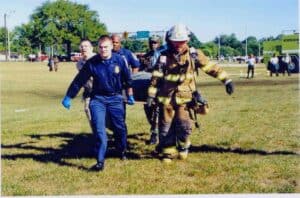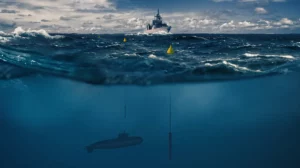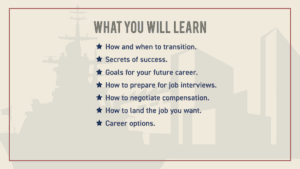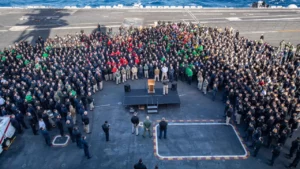Captain Toti’s narrative of the Pentagon attack on September 11, 2001. First published in the Washington Times on October 11, 2001. Later used as the opening passage for the 2006 Random House book of writings by military veterans titled Operation Homecoming.
In the month since this agonizing atrocity began, there has been only one moment when I found myself unable to retain my composure. The event which made manifest all my grief was hearing that Antoinette had died.
“And more to the point, I wonder, where is everybody? Thousands of people work in that building, there should be hundreds streaming out of the emergency exits right now. But at first I see no evacuees.”
We military officers try to pretend we’re emotionally bullet-proof. Although I was acutely aware of the turmoil that had been brewing just beneath the surface in the days since the attack, I had always been able to keep that emotion in check. The surprising news of Antionette’s death hit me like an ambush because I thought she had turned the corner and would pull though. The peculiar thing is I didn’t even know her. Until September 11th, she was merely one of the thousands of nameless Pentagon employees you’d pass in the halls on any given day.
The dreamlike sequence of what I saw when I ran out of the Pentagon and to the point of impact just minutes after the attack plays in my head several times a day. I encounter total devastation. Aircraft parts, most no larger than a sheet of paper, litter the field. I can make out, on one of the larger pieces of aluminum, a red “A” from “American Airlines.” What little is left of the plane lay in a burning fissure in the side of the building. A column of black smoke rises into the air, bending towards the Potomac over the top of the building. A fire fighter sits in the cab of a burning fire truck making a radio call. I wonder, what the heck is he doing? Could that radio still possibly work? (It did.)
And more to the point, I wonder, where is everybody? Thousands of people work in that building, there should be hundreds streaming out of the emergency exits right now. But at first I see no evacuees.
Then as I round the corner of the heliport utility building, I notice a very small number of walking wounded, and then, on the ground, one gravely injured man. This is where the dreamlike sequence ends, and the work begins.
Here on the ground before me lies a Pentagon maintenance worker who was burned so badly that I couldn’t tell whether he was white or black. Amazingly, he was still conscious. An Army officer was kneeling beside him, and since we were just a few feet from the still burning building, the soldier said, “Let’s get him out of here.” A few more military men gathered, and we carried him away from the building to the edge of Route 27 where the first ambulance had just pulled up.
As the EMT tended to him, I looked back down towards the building and saw an open emergency exit door, thick black smoke billowing out. There were other officers tending to the walking wounded that had scattered near the door, but I thought I saw movement from inside the door itself, so I ran back down the hill and into the building.
Just a few feet inside I came across a lady crawling towards the door. I tried to help her up, but she couldn’t stand. So I tried to lift her, but she was not a small woman, and I am not a big man.
I called for help. Two Army officers responded immediately. Then, as a series of secondary explosions began just a few yards away, the three of us half-carried, half dragged the woman out the door to the top of the hill where we laid her by the maintenance worker as a second ambulance arrived.
Most of the lady’s clothing had been burned off and third degree burns covered her. But she was conscious and lucid, and a man with a blue traffic vest that proclaimed “Pentagon Physician” stopped to examine her. So I left, confident that she was in good hands, and ran back down the hill to help evacuate another of the wounded.
When we arrived at the top of the hill with the second man, I noticed that the woman we had just carried up the hill was becoming agitated, saying “I can’t breathe.” I called over to an EMT and asked, “Do you have any oxygen?” He ran to the back of his rig, pulled out a bottle and put it on her. As the flow began and she began to calm down, she looked at me like she wanted to say something. I kneeled down beside her and said “Is that better, are you alright?”
And then came the moment I’ll never forget. She blinked and asked, “Doctor, am I going to die?” Wham. Just like that.
That was a question that I had never imagined myself having to answer. I looked around our little triage area on the side of the road. The first injured man I had come across was no longer conscious and was doing poorly. Another young lady was standing nearby with severely burned hands, screaming hysterically but otherwise alright. The man we carried up the hill most recently was still screaming and was being attended to by a couple of EMTs. And here lie this woman, with no one to attend her but me. What should I say? Should I tell her I wasn’t a doctor?
But there were no answers to be found, so I leaned over the lady and asked, “What’s your name?”
She said “Antoinette.”
I said “No, Antoinette, you’re not going to die. We have a helicopter coming for you, I’m going to stay with you until you’re on it.”
She nodded, and I felt relieved for having said so.
The medevac helicopter arrived a few minutes later. Since the Pentagon’s heliport was in the middle of the attack area, the helo had to land up the hill towards the Navy Annex, on the other side of Route 27. The trek up the hill was surprisingly long and difficult. When we finally got her to the helicopter I yelled out over the noise, “I’ll visit you in the hospital!” then I turned and ran down the hill without looking back. I thought there was more work to be done, but by the time I arrived back at the site, all the injured had already been either loaded onto the helo or transported by ambulance.
I stayed to serve in the rescue effort for the remainder of the day and well into the night, but there was little of substance for us to do. I was troubled by the thought that there might be more people who were injured and struggling to get out. Several times I was told to organize teams to reenter the building, but these plans were never executed either because the different factions in charge couldn’t agree upon what should be done, or because the fire would re-ignite. After a while, we realized that there wasn’t anyone left to rescue, and my mission was changed to organizing to receive remains. But throughout it all, I was comforted by the thought that at least we saved one: Antoinette.
One of the great ironies of the event is that early in the day when we were saturated by wounded there was almost no medical help available. Then later when we had hundreds of doctors, nurses, and paramedics on scene, we had a profound shortage of injuries we could treat. Further, those who were saved in the Pentagon attack were saved not by professional rescuers, not by trained first responders, but by people who were on the scene at the moment of impact. This fact that must be taken into consideration as we prepare for future events of this nature.
The days since the attack have been a continuous stream of fifteen-hour workdays, pushing to prepare for this war. And so it was that I never found the time to make good on my promise to visit Antoinette in the hospital. I called to check up on her, heard that she was in the Washington Hospital Center and doing reasonably well, but then I moved on to what seemed like more pressing matters, allowing the urgent to eclipse the important.
Such was the source of my shock when I was told that Antoinette had died. Her September 19th obituary lists her as Antionette Sherman, 35, from Forest Heights, a woman I met only for a day, but one whom I will never forget.
And so we move on. We will repair the Pentagon, and after we do both the building and our nation will be stronger. Like the president said, we need to turn our grief to rage, and our rage to resolution.
As a military man, I realize that the attacks of September 11th teach us several lessons.
The first is that we face a capable enemy. These attacks were his way of saying, “You have cruise missiles, now I have cruise missiles. You have smart bombs, now I have smart bombs.” We should not underestimate these men.
The second lesson is this: deterrence is dead. Deterrence only works when you can generate fear. When you face an enemy whose goal is to die in the pursuit of evil, then the only way you can deter him is to help him achieve his goal by making him dead before he can execute the evil.
And so our counterattack has begun. But as we focus on our mission, let’s not lose sight of our loss.
Rabbi Marc Gellman has said that it’s improper to think that on September 11th three thousand people died. What really happened was a single individual died three thousand times.
There were three thousand Antoinettes that day, every one of them searching for a human savior who never arrived.
Learn more about Captain Toti here






